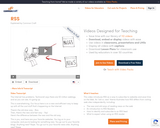
An introduction to RSS as a way to save time reading web sites.
- Subject:
- Communication
- Communications & Media
- English as a Second Language
- Material Type:
- Lecture
- Provider:
- Common Craft
- Author:
- Lee LeFever
- Sachi LeFever
- Date Added:
- 04/23/2007


An introduction to RSS as a way to save time reading web sites.
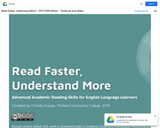
ESOL Reading Level 8 ESOL 260
This advanced academic reading curriculum for English language learners features eight units, each focusing on a different reading skill. Each unit includes presentation slides with a graphic organizer for taking notes; two readings with comprehension questions; academic vocabulary exercises of terms drawn from the readings; and an extension activity. Materials include student textbook, teacher textbook (with answer key and Quizlet links), and presentation slides.
Course Description
Presents reading as a process that involves determination of purpose, selection and adjustment of strategies, analysis and reflection of underlying meanings, and integration of prior knowledge with new knowledge to address the purpose. Covers content comprehension, textual analysis, critical thinking skills, study skills, and language analysis at the high advanced level. Includes reading diverse texts for a variety of purposes. Includes finding themes and main ideas, analyzing figurative language, summarizing, paraphrasing, evaluating sources and analyzing arguments, inferencing, and using context clues, word forms and common affixes. Prerequisites: ESOL placement test OR successful completion of ESOL 250 AND concurrent enrollment in or completion of (ESOL 252 and ESOL 254) or placement into (ESOL 262 and ESOL 264). Audit available.
Intended Outcomes for the course
Understand the development of reading as a process that involves determination of purpose, selection and adjustment of strategies, analysis and reflection of underlying meanings, and integration of prior with new knowledge to address the purpose.
Acquire and use words and phrases found in high advanced-level academic and everyday texts.
Accurately read high advanced level academic and everyday texts which include dense or long complex sentences and paragraphs with appropriate pacing, phrasing, and expression.
Choose from a range of strategies, including some sophisticated ones and integrate them to monitor and/or enhance text comprehension.
Form and express an opinion and draw conclusions based on the information found in high advanced-level academic and everyday texts.
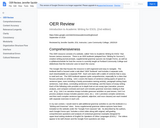
Review of Introduction to Academic Writing for ESOL (2nd edition): https://sites.google.com/site/introtoacademicwritingforesol/
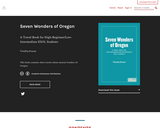
This book contains nine short stories about natural wonders of Oregon written for high-beginner/low-intermediate students of English (lexile range of 500-600). Each story is approximately 225-250 words long and features a picture, a set of self-correcting comprehension questions, a writing prompt, and full citations of sources with links.
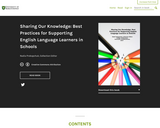
To complete the course ECUR 415.3: Current Issues in EAL, students are required to submit a final paper that reflects their growing knowledge about English as an Additional Language (EAL). EAL is the term used in Saskatchewan to describe students who speak languages other than English and require adequate levels of English to be successful with the school curriculum.
Most students enrolled in the online course ECUR 415 are practicing teachers who are working toward a Post-Degree Certificate in EAL Education (PDCEAL), while continuing to live and work in various locations both within and outside of the province. The certificate program, offered through the College of Education, University of Saskatchewan, is recognized by provincial education authorities as being equivalent to one full year of post-degree study. As such, the certificate equips teachers with the knowledge and expertise to be considered teacher-specialists of EAL Education. The course ECUR 415 also attracts some pre-service teachers who are pursuing a Bachelor of Education degree and have an interest in EAL Education.

Your English Detective is a website that offers adapted Sherlock Holmes stories at the B1 Common European Framework of Reference level. Each story is about 10-15 pages and could be used as extensive reading. In addition, there are Sherlock-inspired lessons and ideas for the ESL classroom, including fanfiction writing prompts.
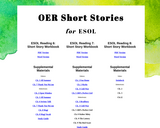
This site contains links to PDF and Word versions of workbooks, along with supplemental materials, for ESOL Reading 6, 7, and 8.
Reading 6 Course Description:
Presents reading as a process that involves determination of purpose, selection and adjustment of strategies, analysis and reflection of underlying meanings, and integration of prior knowledge with new knowledge to address the purpose. Covers content comprehension, textual analysis, critical thinking skills, study skills, and language analysis at the high intermediate level. Includes reading diverse texts for a variety of purposes. Reviews pre-reading techniques and includes finding themes and main ideas, summarizing, paraphrasing, inferencing, and using context clues, word forms and common affixes.
Reading 7 Course Description:
Presents reading as a process that involves determination of purpose, selection and adjustment of strategies, analysis and reflection of underlying meanings, and integration of prior knowledge with new knowledge to address the purpose. Covers content comprehension, textual analysis, critical thinking skills, study skills, and language analysis at the advanced level. Includes reading diverse texts for a variety of purposes. Reviews pre-reading techniques and includes finding themes and main ideas, analyzing figurative language, summarizing, paraphrasing, inferencing, and using context clues, word forms and common affixes.
Reading 8 Course Description:
Presents reading as a process that involves determination of purpose, selection and adjustment of strategies, analysis and reflection of underlying meanings, and integration of prior knowledge with new knowledge to address the purpose. Covers content comprehension, textual analysis, critical thinking skills, study skills, and language analysis at the high advanced level. Includes reading diverse texts for a variety of purposes. Includes finding themes and main ideas, analyzing figurative language, summarizing, paraphrasing, evaluating sources and analyzing arguments, inferencing, and using context clues, word forms and common affixes.

This light activity deals with "silent letters" of English language which are encountered in a large number of English language words. Students read a fairly simple dialogue with the blanks for words containing silent letters. Silent letters, however, are listed while the rest of the letters are blanked. Students find the missing words and become aware of silent letters. Great activity for a warm-up.
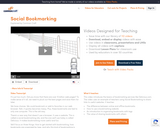
A short introduction to the concept of social bookmarking, using Delicious as the example.
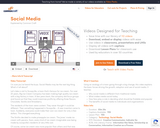
An introduction to Social Media via a story about a small town with many flavors of ice cream.
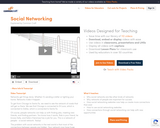
A short introduction to the concepts behind social networking websites.

This textbook was designed to support an English Language Learner pronunciation class; however, it could be used in any intermediate-level speaking and listening class. As you can see outlined in the table below, each unit of this book is centered around a model or mentor text and a corresponding project. There are at least two possible ways you can use these materials.
Option 1: Follow the book in order, starting with the mentor text, progressing through pronunciation features and finishing each unit with the final project.
Option 2: Start with the mentor text, then move directly to introduce the end of module project. Students can submit the final project and then the teacher could assign specific pronunciation feature tasks in order to support students who struggle in specific areas (for a "just-in-time" approach).
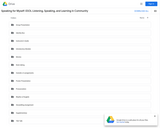
This material has been used for several years with Intermediate to high Intermediate level students in the Chemeketa Community College ESOL program. It has been sourced and designed in response to feedback from and the changing needs of this community. The students take Listening and Speaking classes twice a week. Each class is an hour and a half twice a week, for a total of six hours’ contact time.
A large part of the course is based on a project based learning approach; at this level, using critical thinking skills, collaboration, and presentation skills enables students to develop and practice skills while seeing tangible results boosts confidence and provides a sense of community. Active learning is also a key component. Students have a voice in the themes, topics, and activities assigned and since all have a wealth of experience in many areas, the presentations and projects are engaging and relevant. Much of the success of projects is based on an expectation that students will work on them outside of class time, and homework
assignments are a regular part of the course.
I’ve designed this course as a set of modules which can be used separately or in conjunction with one another; please feel free to select what works for your class and leave the rest. This course is an Open Education Resource and is under an Open License, which means the material is free, can be copied, shared with others, and adapted. I ask that any instructor who used the material attributes it, but users are free to adapt or build on it to create new material for educational purposes. All material within this resource is open source.

Teaching Pragmatics explores the teaching of pragmatics through lessons and activities created by teachers of English as a second and foreign language. This book is written for teachers by teachers. Our teacher-contributors teach in seven different countries and are both native-speakers and nonnative speakers of English. Activities reflect ESL and EFL classroom settings. The chapters included here allow teachers to see how other teachers approach the teaching of pragmatics and to appreciate the diversity and creativity of their endeavors.
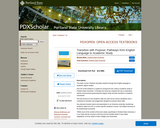
This Open Access Textbook will guide students through their English language to academic degree studies.
Part one of this textbook is a guide for moving from ESL study to academic study at Portland State University*. It includes the resources students will use to understand policies and processes governing their degree study and their transition to academic coursework.
Part two focuses on how academic skills are used across various disciplines and is comprised of activities and assignments designed to practice these skills.
Key elements include culture and expectations in an American university, transferring academic skills from ESL to content-specific academic courses, and helpful exercises to be academically successful.
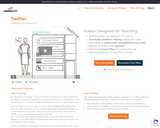
A short introduction to the micro-blogging service Twitter.
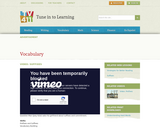
This website has a fun short video and an interactive practice activity to teach and assess common suffixes. It is geared toward adults but would be appropriate for secondary as well.
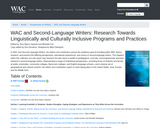
In WAC and Second-Language Writers, the editors and contributors pursue the ambitious goal of including within WAC theory, research, and practice the differing perspectives, educational experiences, and voices of second-language writers. The chapters within this collection not only report new research but also share a wealth of pedagogical, curricular, and programmatic practices relevant to second-language writers. Representing a range of institutional perspectives—including those of students and faculty at public universities, community colleges, liberal arts colleges, and English-language schools—and a diverse set of geographical and cultural contexts, the editors and contributors report on work taking place in the United States, Asia, Europe, and the Middle East.
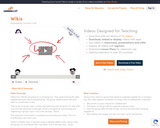
A short introduction to wikis focused a group of people that plan a camping trip using a wiki.
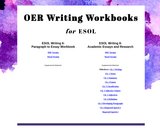
This site contains links to PDF and Word versions of workbooks, along with supplemental materials, for ESOL Writing 6: Paragraph to Essay Workbook and ESOL Writing 8: Academic Essays and Research.
Writing 6 Course Description:
Review of the writing process and development of the essay. Covers descriptive, narrative, process, and comparison/contrast essays. Review of verb tenses, sentence types, punctuation, and spelling patterns. Introduction to adverb and adjective clauses, reported speech, passive voice, and gerunds and infinitives.
Writing 8 Course Description:
Develops upper-advanced writing skills. Includes grammar and mechanics, and builds upon expository essay styles by introducing outside research. Explores concepts including but not limited to the cultural expectations related to a U.S. academic environment with an increased emphasis on basic research conventions. This is the fifth course of a five-course sequence.